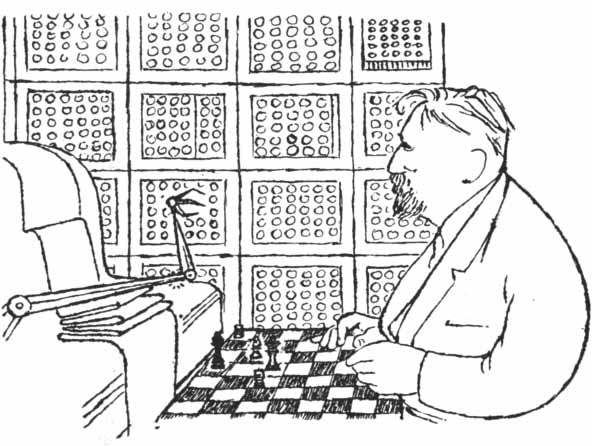Thinking machines?
The Turing test doesn’t measure a computer’s intelligence, but it does say something about its usefulness — here’s how.
Sarah Lewin • June 13, 2014

CAPTION: A chess-playing machine as illustrated in 1950. [Image credit: Scientific American]
A few days ago, the University of Reading announced that a ‘chatbot’ — a computer program that responds to human conversation — had passed the Turing test. In this case that meant 10 out of 30 judges thought it was more human than an actual human they were chatting with simultaneously, although the legitimacy of these criteria has proven controversial. Even a true victory here wouldn’t mean a computer that can hold intelligent conversations — just one whose programmers were able to predict the course of interactions extremely well. So what’s the point?
As many artificial intelligence researchers complain, the Turing test isn’t a good milestone on the path to machine intelligence because a machine doesn’t have to be indistinguishable from a human to be good at its job, and a smart-talking program doesn’t always have inner depth. But over and over, groups try and tackle the test because it represents a fundamental need people have for machines — easy and flexible communication.
No computer can converse perfectly as a human, but that hasn’t stopped programmers from making the most of human-machine communication. The good news is that the features that make an ‘artificial intelligence’ pleasant to interact with are rarely the most computationally intensive — the therapist ‘bot ELIZA used just 200 lines of code to charm its visitors in 1964. Modern consumers too have proven ready to embrace technology when it comes with a friendly face, even if it doesn’t show true intelligence: Look at Siri, whose scripted, sassy answers fill pages of screenshots online.
Early computer researchers also focused on another seemingly useless task, similar to teaching a robot to exchange pleasantries: creating a chess-playing computer program. The information theorist Claude Shannon proposed a hypothetical chess machine in a 1950 Scientific American article, questioning whether said machine could be considered to ‘think,’ and it stuck in the popular consciousness as an easily-provable test of machine intelligence.
In time, a grandmaster-defeating computer was created by IBM, but its lasting legacy was the sophisticated programming and mechanical knowledge that emerged in the process. Teaching a robot to win at chess was simply a shorthand for developing sophisticated machines that could understand rules, strategize and think on a human level.
The Turing test works as a similar shorthand. Though it tests a computer’s ability to mimic human conversation, it reflects the overarching goal of making machines interact seamlessly with humans — a goal that we’re approaching every day.
In a series of pictures labelled ‘inevitable advantage of man over the machine’ in the 1950 article, a man first loses to a chess playing machine, alters the machine’s instructions in the second panel, and in the third panel finally wins.
Even though it’s less ‘intelligent,’ that chess-playing machine knew how to do what the user wanted — and smooth communication is the key.
2 Comments
Thinking machines! I think it just our dream that machine can think but let’s see what happen in future most of the people want to learn about the machine and want to work on its thinking but its not possible near to me.
That’s an ingellitent answer to a difficult question xxx